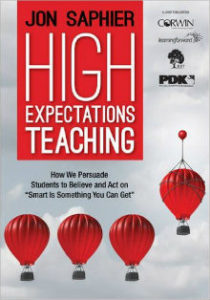Helping Students Buy Into High Expectations
High Expectations Teaching: How We Persuade Students to Believe and Act on “Smart Is Something You Can Get”
By Jon Saphier
(Corwin, 2017 – Learn more)

Fans of Carol Dweck’s Mindset will be excited about John Saphier’s High Expectations Teaching, a book that promises to build on Dweck’s work by delivering concrete strategies for boosting student confidence in the classroom.
I was eager to delve further into questions like: How can teachers provide encouragement to students who give up easily, or who see low scores as evidence of their own deficiencies rather than opportunities for growth? If teachers want students to grow academically and to enjoy the learning process, it is essential that they help students believe in themselves.
What the book has to offer

Teachers who have engaged extensively in professional conversations surrounding mindsets and pedagogy, however, might find the book to be a bit thin. At 139 pages (not including appendices), the book seems to be designed for those short on time rather than those who are interested in an in-depth explorations of complex topics like “culturally relevant teaching” that are only briefly addressed here.
The first two chapters set up the book by providing an overview of intelligence theories as well an introduction to Dweck’s work. The point that Saphier wants to drive home at the start of High Expectations Teaching is that all students are capable of learning, and that smart is, as the maxim goes, “something that you get.” Indeed, beliefs that some students are inherently smarter or more capable than others can have toxic effects in the classroom and on society itself.
However, given the breadth of research on theories of intelligence that has taken place over the last few decades, claims such as “the bell curve of ability is plain wrong” and “differences of color and culture have nothing to do with the capacities of children’s brains” feel more dated than bold (back cover, 34).
Brights and slows
Chapter three delves into discussions about language in the classroom and is useful for reflecting on small interactions with students. Saphier lists 12 behaviors that teachers use to unconsciously classify students as “brights” and “slows,” for example (41). He includes a list of reflection questions that teachers can use to examine their own behaviors, such as:
“Do I smile and nod more toward ‘highs’?”
“Do I lean more toward ‘brights’?”
“Do I look ‘brights’ more in the eyes?”
“Do I give ‘slows’ fewer opportunities to learn new material?”
“Do I allow ‘brights’ longer to respond?”
Saphier offers a few tips for giving support to students and for pushing back against student helplessness. He also emphasizes the importance of wait time, and “sticking with a student” – practices that encourage student participation and that may ultimately result in higher student achievement. I imagine chapters like this leading to productive conversations in Professional Learning Communities (PLCs).
Chapters four and five list recommendations for classroom practices and instructional strategies and provide QR codes linking to teaching videos. Readers can access these now on Saphier’s education consulting website, Research for Better Teaching. Many of the videos seem best suited as fodder for in-service learning days rather than as quick examples of the best practices that Saphier describes in the book.
Several videos are quite lengthy, and some include the instruction to print out documents to distribute to teachers. Teaching Channel’s collection of videos offers a more user-friendly alternative for teachers looking for examples of formative assessments in action, building positive classroom climates, etc. Saphier also lists Teaching Channel as a recommended resource.
Teaching Effort
Entire cottage industries of education consultants and authors have emerged around Dweck’s research on mindsets and around Angela Duckworth’s work on “grit.” Perhaps this is why we also find a chapter on “teaching effort” in High Expectations Teaching (chapter 6). A simple Google search will produce an abundance of resources and articles containing strategies for promoting grit, perseverance, effort.
Still, I will use and modify several resources in this chapter like the “effort self evaluation” checklist, and Saphier’s list of effective learning strategies. Teachers can use prompts like: “Following failure (or a much lower grade than I expected), I create a plan for improving my understanding and grades, and share the plan with my teacher” to spark reflective discussions about habits that may be helping or hindering a student’s progress (97).
I’m happy to add High Expectations Teaching to my bookshelf, but further reading will be necessary for teachers who are truly interested in cultivating student agency for all learners in the classroom. I, for one, am planning to revisit Teaching to Transgress by bell hooks; I also have Ruth Charney’s Teaching Children to Care: Classroom Management for Ethical and Academic Growth, K-8 on my reading list.
Amy Williams teaches MYP and DP English courses at the International School of Düsseldorf, an IB World School. Before moving to Germany, she was a tenured educator in Upstate New York. She holds masters degrees in English and Adolescence Education. Her work has appeared in publications like Education Week Teacher and ReadWriteThink. She tweets @MsWilliamsEng.
Read another MiddleWeb review of High Expectations Teaching.


































